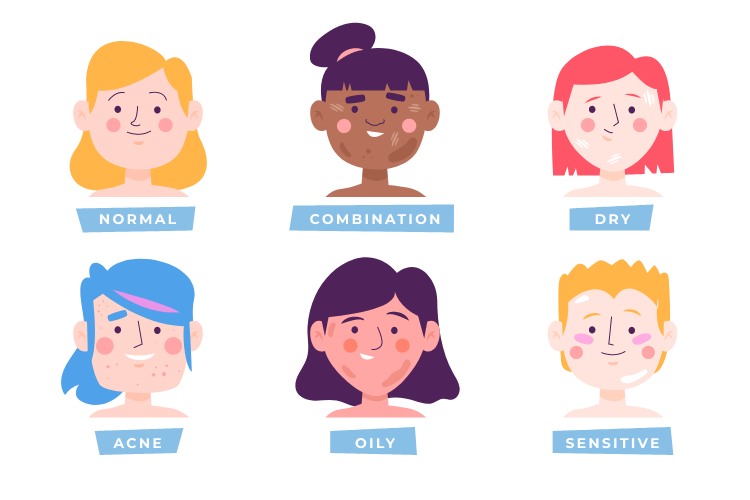Table of Contents
How do I know what Skin Type have?
Skin Type – Different criteria for classifying different skin types. Such as skin colour and its response to sun exposure. This classification is to decide on the appropriate kind of sun protection factor or to predict the risk of skin cancer, among other things. However, from a cosmetic point of view, the skin is classified according to several factors on which its balance will depend: re-epithelialization, desquamation, sebaceous secretion, hydration, and level of sensitivity. Each skin is different, so it is essential to know all the types of skin and the diseases that can appear on each of them.
Skin type is determined by genetics, although it is also affected by other factors such as age, external aggressions, temperature, and ambient humidity. So each kind of death each skin is differenter will have its characteristics and require different care.
According to these characteristics, we can find five types of healthy skin: normal, dry, oily, combination (has oily and dry properties), and sensitive. Below, we detail the main characteristics of each skin type.
Normal Skin Type
Normal skin is smooth and nearly even. It is skin that has an actual texture, without imperfections and a smooth and clean appearance, without the need for special care. The surface of normal skin is generally smooth, and its pores are unremarkable. This type of skin has a good hydration level, so there are no obvious imperfections. Normal skin typically responds well to changes in temperature and humidity and quickly resists daily aggressions such as pollution or UV rays.
Characteristics of Normal Skin
- softness, tiny pores does not cause problems.
- pink tint
- good circulation and elasticity
Tips for Normal Skin
- Gentle exfoliation once or twice a week removes impurities and dead skin cells.
- If you apply the face cream with a gentle massage, you stimulate blood circulation.
- Take care of your eyes with a special cream for the contour and get a radiant look
Dry Skin Type
Dry skin is usually temporary, caused by external factors such as weather conditions, low air humidity, and immersion in hot water. However, dry skin can occur more frequently in some people and even last a lifetime. Although usually not severe, if left unattended, it can cause other skin problems such as eczema or be more prone to infection as dry skin can crack, leaving it more exposed to bacteria.
The signs and symptoms of dry skin can vary depending on different factors such as age, health condition, or its cause. In general, it considers a feeling of tightness and roughness. It may also turn ashen grey, peel, itch, red, and show small cracks. Tiny cracks appear, which can be more profound and even bleed in more severe cases—cracked skin on dehydrated skin.
Atopic skin is a skin disease characterised by dry skin that flakes and irritation and causes bothersome symptoms such as itching. Its leading cause is a genetic predisposition. However, some factors trigger its appearance or make the problem worse. Hence, These factors can be environmental, allergic, food, and even be related to certain clothes.
Characteristics of Dry Skin
- they are tight and prone to itching.
- rough and scaly appearance.
- They are susceptible to external influences such as temperatures.
Tips for Dry Skin
- You can help your skin from within by eating a healthy diet and drinking 2 litres of water a day.
- Always use day creams with SPF to protect your skin from UV rays.
- Serums are the perfect complement to your moisturiser.
- Choose treatments infused with natural oils to soothe and soothe your skin.
Oily or Oily Skin Type
Oily skin defines by the constant appearance of blackheads and pimples on the skin. It has a shiny appearance, enlarged pores, and an uneven texture. The characteristics of this type of skincare are because the sebaceous glands of the skin are larger and more numerous than usual.
Characteristics of Oily Skin
- large pores
- the skin shines.
- tendency to imperfections.
Tips for Oily Skin
- large pores.
- the skin shines.
- tendency to imperfections.
Combination Skin Type
a variety of standard and dry areas with oily areas is called mixed skin. Oily spots are on the forehead, nose, and chin, normal or dry spots on the cheeks. This type of skin is usually smooth and shiny.
Properties of Combination Skin
- have a greasy sheen.
- drier cheeks.
Tips for Combination Skin
- Thoroughly clean your skin before applying facial care products.
- use warm water.
- Apply a moisturiser regularly (a hazelnut is enough).
- Always use combination skin products.
Sensitive Skin Type
Sensitive skin is more susceptible to external influences such as stress, hot, dry air, or ultraviolet light. When the skin is out of balance, it feels tight, itchy, and red. For this reason, sensitive skin needs special care that soothes it while reinforcing its natural protective barrier and helping it be more resistant.
Characteristics of Sensitive Skin
- sensitive to external factors.
- tight and itchy.
- he often blushes.
Tips for Sensitive Skin
- Use a cream that protects your skin from harmful environmental influences.
- After cleansing your face, gently pat your skin dry with a towel instead of rubbing it vigorously.
- Use fragrance-free products as they can irritate the skin.
- Take care of your diet: Spicy foods are not suitable for your skin.
Mature Skin Type
As we age, the skin goes through many different processes that change its appearance, structure, and activities. Therefore, These include reduced cell activity, slower regeneration, reduced collagen production, or UV damage. Mature skin lacks hydration and elasticity. But with innovative skincare products, fine lines, wrinkles, and age spots reduce.
Characteristics of Mature Skin
- less elasticity
- lack of hydration.
- Expression lines, wrinkles, or dark spots.
Tips for Mature Skin
- Protect your skin from the sun: Excessive ultraviolet radiation leads to premature skin ageing.
- Moisturizing masks with high-quality oils intensively care for your skin.
- Use creams that stimulate cell regeneration in your skin.
How do you Recognize your Skin Type? The Two Easy Ways to Discover Skin Type.

Knowing my skin type is not always easy as everyone’s skin is different and changes over time. However, there are two easy ways to find out:
1. Bare Face Method
If you decide to use this method to determine your skin type, you should first clean your face thoroughly with a mild cleanser and pat dry. Leave your skin uncovered without applying another moisturiser, serum, or treatment. After 30 minutes, examine your cheeks, chin, nose, and forehead to see if they are glowing. After another 30 minutes, assess whether your skin feels dry, especially when you smile or other facial expressions. If you think your skin is tight, it’s probably dry. On the other hand, if you notice a noticeable shine on your nose and forehead, your skin is perhaps normal or combination. If you see a sheen on your cheeks in addition to your forehead and nose, you probably have oily skin.
2. Blotting sheet method
This method is much faster and often one of the best ways to tell the difference between oily and dry skin types. To do this, take a piece of dry paper and rub it gently on the different areas of your face. Next, hold the form up to the light to assess how much fat is visible. If the sheet has picked up little or no oil, you most likely have a dry skin type. On the other hand, if the paper shows fat accumulations in the forehead and nose area, your skin is normal or combination skin. After all, if the sheet saturates with fat, you most likely have oily skin.
Conclusion
As we already know, the skin is the largest organ in the body and is as complex and intelligent as the lungs, heart, liver, and other vital organs. Each skin type has its characteristics, so an essential step in caring for it is to know your skin type and how it reacts to particular circumstances. For this reason, in this article, you will find all the necessary information to identify your skin type and thus know how to take care of it as it deserves.


